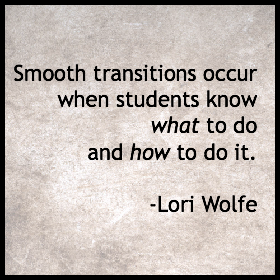This is an article I wrote for Really Good Stuff Blog a few years ago. Still holds true so I am re-posting it here!
Happy Teaching!
Lori
“If only I had more time in a school
day...”
Have
you ever caught yourself uttering this phrase?
You can easily add those instructional minutes to your day by explicitly
planning for your transition times. Carefully
considered transition times offer the key to maintaining an optimal learning
environment, minimizes disruptions and behavior problems while maximizing
instructional time. By providing the
structure of predictable routines, procedures and behavioral expectations,
teachers offer their students, including second language learners and those who
struggle with poor attention and impulsivity, an avenue to success during
transition times.
 Plan
for the transition periods in advance.
Take a few minutes and think about the transition times that occur in
your classroom.
Plan
for the transition periods in advance.
Take a few minutes and think about the transition times that occur in
your classroom.
Common
transition times include:
·
entering the classroom first
thing in the morning
·
changing from one subject to
another
·
leaving or coming into the
room after assemblies
·
recesses or lunch, clean up
time at the end of the day
The
first step in planning for transition times is selecting a signal that you will
use for each transition time. Be
consistent and use the same signal for all transitions. Make sure it is a visual and auditory signal. Provide enough “wait time” for students to
respond.
Choose
a method to instill a “sense of urgency” to the transition. Students respond well to the feeling that
their work and time is important. By
giving the situation “a sense of urgency” students respond quickly. Set a timer, count, or sing a song to give
students that “sense of urgency. Often
simply saying, “Class we have 40 seconds to enter the room quietly and slowly,
return to our desks/tables safely and begin reading. Ready go.” is sufficient to instill that
sense of urgency.
Always
follow the same procedure. During
transition times where students leave the room, teach them to put their
materials away, stand up, push in their chairs, move slowly and safely to the
door. During transition times to the
next activity include an activity that will help children adjust to the
change. Consider adding a quick
opportunity to stretch, a song that focuses on the new activity or subject,
skip counting or reciting a poem. This
gives students a break to readjust and provides slower students a bit more time
to complete the transition. Be
deliberate in ending this very short brain break. Go right to work, don’t waste
time here. This creates a “sense of
urgency” and shows your students that you value their time and work.
Be
consistent. Smooth transitions occur
when students know what to do and how to do it.
Adhere to your schedule. Have
work ready for students. As students
enter each morning have a plan for exactly what they will do as they
enter. Look at your morning and plan for
success. Teach students to enter the
room and
·
Hang up backpacks, jackets
and coats
·
Turn in homework
·
Sign up for hot or cold lunch
·
Find their seats
·
Begin reading, handwriting or
whichever morning activity you choose
Consider
playing music or setting a timer the students can hear for the first minute
students are entering the room. Be very
consistent and choose the same amount of time the music ends or the timer goes
off in order to create that “sense of urgency”.
Transition times will be efficient and productive parts or your
educational day when you value your students’ time and work.
Finally,
good teaching of any routine and procedure is the key to success. Remember to explain the expected behavior,
explicitly model the routine and procedure, practice, practice, practice and
finally provide feedback.
Congratulations, you are on your way to smooth, efficient, and safe
transition times.
We created a helpful worksheet you can download
for free. Click here to download, My Plan for Smooth & Efficient Transitions!
What
strategies and activities do you use during transition times? Please share your ideas with us!
Happy
Teaching!
Lori
Wolfe
Fun ToTeach

No comments:
Post a Comment